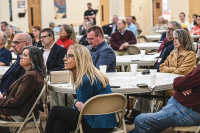A place where everyone belongs: Equine rescue effort leads to higher calling
As the recession worsens, more and more animals need help, and fewer and fewer funding sources are available to animal rescue non-profits.
“This is the worst year we’ve seen. I think that’s true for everybody in this business,” said Karen Owens, who with her husband Jim operates the S.T.A.R. ranch animal rescue organization.
S.T.A.R. ranch, though, is not your average animal rescue organization.
“This is a cross between an animal rescue, a M.A.S.H. unit, and a hospice,” said Jim.
On a recent Wednesday morning at the ranch — located in the Jonathan Creek community of Haywood County near Interstate 40 — the Owens had 83 animals on the premises, all of them rescued from Haywood County homes and farms.
Just before lunch, Karen filled the horses’ feed bucket. Lucy, a 24-year-old Belgian draft horse, has gained 500 pounds since she was rescued in November of last year. Lucy was saved from a farmstead where she had developed laminitis, or Barbaro’s Syndrome, an often-deadly hoof condition. Lucy’s hind legs had withered, and she was in chronic pain because of multiple abscesses. She couldn’t even lie down to sleep, because she knew she wouldn’t be able to push herself back up.
“The old saying is ‘If you lose the feet, you lose the horse,’” said Karen, who grew up on a farm in Pickaway County, Ohio, and later played oboe in the Columbus Symphony Orchestra.
All of the Owens’ rescues come from word-of-mouth referrals and a close working relationship with Haywood County Animal Control. Karen might end up driving to a farm where a horse is in distress because his owners can’t afford to feed him. Once there, she often finds other animals in trouble as well.
“It was impossible to rescue the horse and leave the dogs behind,” Karen said.
Although S.T.A.R. has saved hundreds of dogs, cats and goats since 2007, they are the only local outfit that saves horses, which are treated as property by county and state laws, not as pets.
When Karen goes out to rescue animals, she’s also out to change hearts and minds.
“People don’t want to rat out their neighbors or their kin. You got to get into their heads. It’s easier without a uniform,” Karen said.
The ranch is currently home to more than 30 dogs, lots of cats, 14 horses and five goats. Moses, a tricolor goat, was found on the steps of a local church, bleeding from the neck as a result of a coyote attack.
Every animal at S.T.A.R. ranch has a story, and increasingly, those stories are drawing people who have their own issues.
Judy Vail is one of the ranch’s most regular volunteers. For her, scooping cat litter, bottle feeding kittens and administering medicine is a kind of therapy.
“I come here two times a week. It’s my spiritual rehab,” said Vail.
In the past year, the Owens have also welcomed more formal delegations. Young people from Meridian Behavioral Health, the Junaluska Methodist Camp, Upward Bound and Haywood Vocational have all come to experience the feeling of caring for hurt and sick animals.
“There’s an animal here for everybody. It doesn’t matter what a person’s perceived limitations are. It’s a level playing field here. The animals are unconditional,” Karen said.
Not all of the animals the Owens rescue survive. After Lucy — the Belgian draft horse — arrived, things were touch and go for a while.
“If we can’t control the pain and we can’t give them quality of life, then we don’t prolong their life,” Karen said. “It’s a human thing to want to prolong life, not an animal thing.”
Karen worried that Lucy’s time had come because her body couldn’t take any more pain medication and her hooves still couldn’t hold her weight.
“I looked her in the eye in December and, lo and behold, she wasn’t ready to go,” Karen said. “That hoof came back. That was our Christmas miracle.”
Lucy is walking gingerly now but she’s gaining strength everyday. At her age, she still has lots of good years in front of her. Without the Owens, she would be dead. That’s what’s in it for Karen.
“I probably quit once a month because the task seems overwhelming. But when an animal turns around and you know he’s gonna make it, it’s worth all the heartaches.”
S.T.A.R. ranch spends $50,000 per year caring for animals that are dying from neglect or in line to be killed. About 65 percent of the money goes directly to feed and hay, and the rest is spent on veterinary services, farriers, supplies and maintenance.
There are no paid employees. All the work of feeding, caring, and worrying is undertaken by the Owens’ and a small volunteer staff.
The venture started as a kind of retirement hobby for the couple when they relocated to Haywood County in 2005. But it rapidly became a calling.
The business’ first customer was their next-door neighbor, a racehorse named Silicone City. Karen convinced the horse’s owner to allow her to find him a home, and she ended up placing Silicone City with an equine rehabilitation center in Tennessee.
“In the process of finding homes for all of his many animals, people started to call and it just began to happen,” Karen said.
“It” is a 10-acre mountain tract that once belonged to James Moody and later served as the base for the Space Technology And Research foundation, which was created by Greta Woodrew, a famous psychic.
When the Owens purchased the property, they liked the wrought iron entrance gate, so they kept the name. Save The Animals Rescue became a tax-exempt nonprofit with a board in 2007. The ranch house, two-story barn and property are deeded to S.T.A.R.
“We want to make sure this work continues when we’re gone,” Karen said.
S.T.A.R. ranch doesn’t get any public money. Its operating budget, which has grown from $20,000 in 2005 to more than twice that, has been raised by the Owens through grants, contributions, adoption fees, and small-scale fundraisers at places like the Tractor Supply Co. in Waynesville.
This year, Jonathan Creek Elementary School students, Meggan and Corey Lapkoff and Amanda Guest put up a lemonade stand in Maggie Valley that raised more than $300 for the ranch.
For Karen and Jim, support like that affirms that S.T.A.R. ranch is a labor of love for themselves and for many others in the community.
“We’re really a sanctuary. It’s beyond a shelter,” Karen said. “It’s a place where people can come to give and receive.”
star-ranch-rescue.com





